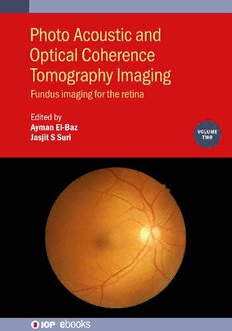
Photo Acoustic and Optical Coherence Tomography Imaging, Volume 2: Fundus Imaging for the Retina PDF
Preview Photo Acoustic and Optical Coherence Tomography Imaging, Volume 2: Fundus Imaging for the Retina
Photo Acoustic and Optical Coherence Tomography Imaging, Volume 2 Fundus imaging for the retina Online at: https://doi.org/10.1088/978-0-7503-2056-6 Photo Acoustic and Optical Coherence Tomography Imaging, Volume 2 Fundus imaging for the retina Edited by Ayman El-Baz University of Louisville, Louisville, KY, USA and University of Louisville at Alamein International University (UofL-AIU), New Alamein City, Egypt Jasjit S Suri AtheroPoint LLC, Roseville, CA, USA IOP Publishing, Bristol, UK ªIOPPublishingLtd2022 Allrightsreserved.Nopartofthispublicationmaybereproduced,storedinaretrievalsystem ortransmittedinanyformorbyanymeans,electronic,mechanical,photocopying,recording orotherwise,withoutthepriorpermissionofthepublisher,orasexpresslypermittedbylawor undertermsagreedwiththeappropriaterightsorganization.Multiplecopyingispermittedin accordancewiththetermsoflicencesissuedbytheCopyrightLicensingAgency,theCopyright ClearanceCentreandotherreproductionrightsorganizations. PermissiontomakeuseofIOPPublishingcontentotherthanassetoutabovemaybesought [email protected]. AymanEl-BazandJasjitSSurihaveassertedtheirrighttobeidentifiedastheeditorsofthiswork inaccordancewithsections77and78oftheCopyright,DesignsandPatentsAct1988. ISBN 978-0-7503-2056-6(ebook) ISBN 978-0-7503-2054-2(print) ISBN 978-0-7503-2055-9(myPrint) ISBN 978-0-7503-2057-3(mobi) DOI 10.1088/978-0-7503-2056-6 Version:20221201 IOPebooks BritishLibraryCataloguing-in-PublicationData:Acataloguerecordforthisbookisavailable fromtheBritishLibrary. PublishedbyIOPPublishing,whollyownedbyTheInstituteofPhysics,London IOPPublishing,No.2TheDistillery,Glassfields,AvonStreet,Bristol,BS20GR,UK USOffice:IOPPublishing,Inc.,190NorthIndependenceMallWest,Suite601,Philadelphia, PA19106,USA Withloveandaffectiontomymotherandfather,whoselovingspiritsustainsmestill. —Ayman El-Baz To my late loving parents, immediate family, and children. —Jasjit S Suri Contents Preface xii Acknowledgements xiii Editor biographies xiv List of contributors xv 1 Texture interpretability of fundus imaging and diabetic 1-1 retinopathy: a review Ahmed Naglah, Mohammed Ghazal, Fatma Taher, Ali Mahmoud and Ayman El-Baz 1.1 Introduction 1-1 1.2 DR interpretability approaches 1-2 1.2.1 Attention based models 1-2 1.2.2 Feed-forward style localization maps 1-4 1.2.3 Occlusion based models 1-4 1.2.4 Hand-crafted texture analysis methods 1-5 1.2.5 Other approaches 1-5 1.3 Texture challenges in a fundus imaging dataset 1-6 1.3.1 Intensity based analysis is challenging for DR classification 1-6 1.3.2 Image gradient analysis is challenging for DR classification 1-7 1.4 Detecting texture patterns with the aid of deep learning 1-7 1.4.1 Convolutional neural network model 1-14 1.4.2 Kernel clustering 1-15 1.4.3 Visualization 1-15 1.5 Limitations and challenges 1-22 1.6 Conclusion 1-22 References 1-22 2 A two-phase novel optic disc detection algorithm based on 2-1 vesselness distribution and a fuzzy classifier using vessel ramification and fundus color features Mehmet Nergiz 2.1 Introduction 2-1 2.2 Materials and methods 2-4 2.2.1 Materials 2-4 vii PhotoAcousticandOpticalCoherenceTomographyImaging,Volume2 2.2.2 Methods 2-5 2.3 Evaluation and results 2-24 2.4 Discussion and conclusion 2-26 References 2-32 3 Application of enface image registration/alignment to 3-1 introduce new ocular imaging biomarkers Zahra Amini, Rahele Kafieh, Mahnoosh Tajmirriahi, Zeinab Parsons and Hossein Rabbani 3.1 Introduction 3-1 3.1.1 Anatomic landmarks of the eye 3-2 3.1.2 Enface image modalities 3-3 3.2 Feature extraction 3-4 3.2.1 Vessel segmentation 3-4 3.2.2 Optic disc segmentation 3-6 3.2.3 FAZ segmentation 3-7 3.3 Registration of fundus and OCT images 3-7 3.4 Registration and alignment of ocular images in the right and 3-9 left eyes 3.4.1 Symmetry analysis of vessel maps in the right and left eyes 3-9 3.4.2 Symmetry analysis of macular OCTs in the right and 3-10 left eyes 3.4.3 Alignment of ONH OCTs in the right and left eyes 3-12 3.5 Registration of FFA and SLO images 3-12 3.5.1 FFA and OCT registration using SLO images 3-12 3.5.2 MA detection in OCT and FFA 3-15 3.6 Conclusion 3-20 References 3-21 4 Existing techniques used for retinal image analysis in the 4-1 automated detection and prediction of AMD Samina Khalid, Usman Akram, Tehmina Sheryar and Farah Karim 4.1 Introduction 4-1 4.2 Existing automated diagnosis methods used for AMD 4-4 4.2.1 Pre-processing techniques 4-4 4.2.2 Retinal component extraction from fundoscopic images 4-4 viii PhotoAcousticandOpticalCoherenceTomographyImaging,Volume2 4.3 Retinal component extraction from OCT images 4-10 4.3.1 Retinal layer extraction 4-11 4.3.2 Drusen detection from extracted retinal layers 4-12 4.3.3 AMD lesion detection 4-14 4.4 Comparative analysis of diagnosis systems 4-16 4.5 Research limitations and challenges 4-17 4.6 Conclusion 4-21 References 4-22 5 Interobserver variability in the determination of diabetic 5-1 retinopathy and quality of fundus image S´ılvia Reˆgo, Matilde Monteiro-Soares, Filipe Soares and Marco Dutra-Medeiros 5.1 Introduction 5-1 5.2 Fundus imaging 5-2 5.2.1 The diabetic retinopathy classification process 5-2 5.2.2 Fundus image quality 5-3 5.3 Interobserver variability and reliability of DR classification 5-4 5.4 Image quality 5-5 5.5 Implications for clinical practice 5-6 5.6 Conclusion 5-7 References 5-7 6 Computer-aided diagnosis of Plus disease in preterm infants 6-1 Sivakumar Ramachandran, Bejoy Abraham, P Niyas, Anand Vinekar and Renu John 6.1 Introduction 6-1 6.1.1 Retinal image analysis 6-1 6.2 Computer-aided diagnosis system 6-3 6.2.1 Resources and evaluation metrics 6-4 6.3 Development of a computer-aided diagnostic system 6-6 6.3.1 Tortuosity detection and quantification using a fully 6-7 convolutional neural network 6.4 Results and discussion 6-11 6.5 Conclusions 6-13 References 6-13 ix
